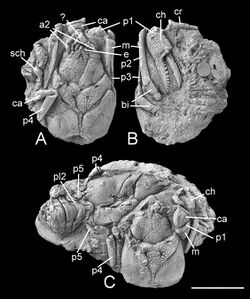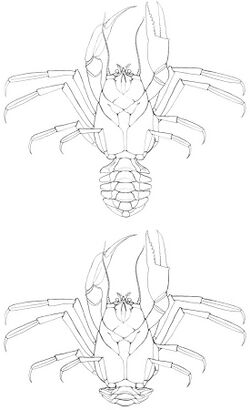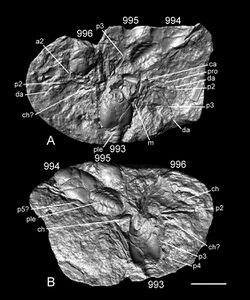Biology:Eocarcinus
| Eocarcinus | |
|---|---|

| |
| Holotype (top) and paratype (bottom) specimens | |
| Scientific classification | |
| Kingdom: | |
| Phylum: | |
| Subphylum: | |
| Class: | |
| Order: | |
| Infraorder: | |
| Family: | Eocarcinidae Withers, 1932
|
| Genus: | Eocarcinus Withers, 1932
|
| Species: | E. praecursor
|
| Binomial name | |
| Eocarcinus praecursor Withers, 1932
| |
Eocarcinus praecursor is a Jurassic species of decapod crustacean, sufficiently distinct from its relatives to be placed in its own family (Eocarcinidae).[1] Often considered the oldest true crab, it was considered by a 2010 study to be an early member of the Anomura. However, a reanalysis in 2020 again found it to be the earliest known stem-group crab.[2]
Distribution
It lived during the early Pliensbachian age (Lower Jurassic),[3] and has been found in rocks at two sites in the United Kingdom – Mickelton Tunnel (near Aston Magna), Gloucestershire and Runswick Bay, Yorkshire.[4]
Description
In many of its characters, it represents a transitional stage between the Glypheoidea and the Middle Jurassic crabs in the Prosopidae.[3] Since its ancestors were long-tailed decapods, and its successors were short-tailed crabs, Eocarcinus has been described as "the lobster who decided to become a crab".[5] Previously considered to be the oldest known true crab, a 2010 revision concluded that Eocarcinus could not be accommodated among the Brachyura, and was instead transferred to the Anomura.[6] However, a 2020 reanalysis found that it was again the earliest known stem-group crab, but that it had not undergone the process of carcinisation.[2]
References
- ↑ Sammy De Grave et al. (2009). "A classification of living and fossil genera of decapod crustaceans". Raffles Bulletin of Zoology Suppl. 21: 1–109. http://rmbr.nus.edu.sg/rbz/biblio/s21/s21rbz1-109.pdf.
- ↑ 2.0 2.1 Scholtz, Gerhard (November 2020). "Eocarcinus praecursor Withers, 1932 (Malacostraca, Decapoda, Meiura) is a stem group brachyuran" (in en). Arthropod Structure & Development 59: 100991. doi:10.1016/j.asd.2020.100991. PMID 32891896.
- ↑ 3.0 3.1 M. Krobicki; M. Zaton (2008). "Middle and Late Jurassic roots of brachyuran crabs: Palaeoenvironmental distribution during their early evolution". Palaeogeography, Palaeoclimatology, Palaeoecology 263 (1–2): 30–43. doi:10.1016/j.palaeo.2008.01.025. Bibcode: 2008PPP...263...30K.
- ↑ Danièle Guinot; Marcos Tavares (2001). "Une nouvelle famille de Crabes du Crétacé, et la notion de Podotremata Guinot, 1977 (Crustacea, Decapoda, Brachyura)". Zoosystema 23 (3): 507–546. http://www.mnhn.fr/publication/zoosyst/z01n3a10.pdf.
- ↑ Anonymous (1932). "The Royal Society Conversazione". British Medical Journal 1 (3724): 946–947. doi:10.1136/bmj.1.3724.944. JSTOR: 1st page, 2nd page
- ↑ Rodney M. Feldmann; Carrie E. Schweitzer (2010). "Is Eocarcinus Withers, 1932, a basal brachyuran?". Journal of Crustacean Biology 30 (2): 241–250. doi:10.1651/09-3230.1.
Wikidata ☰ Q774109 entry
 |



